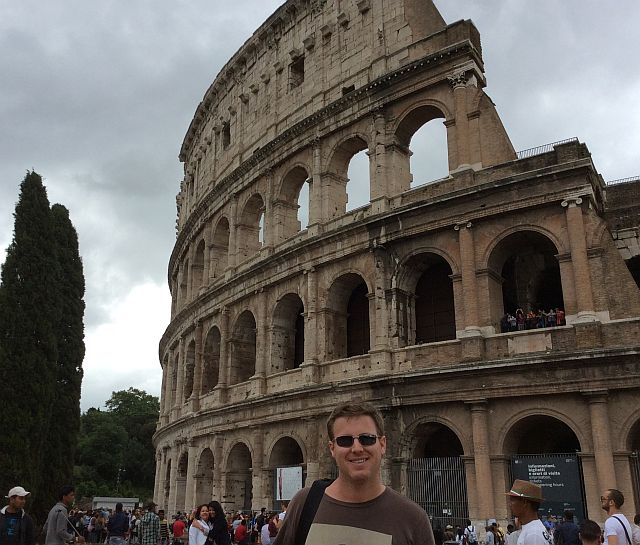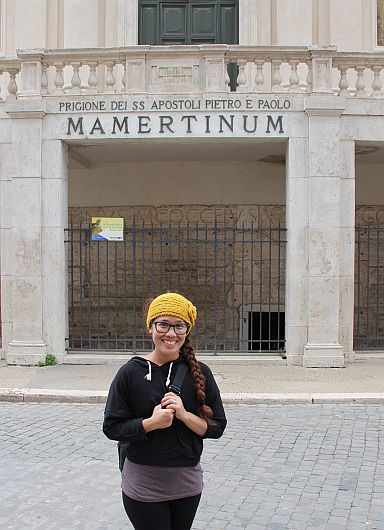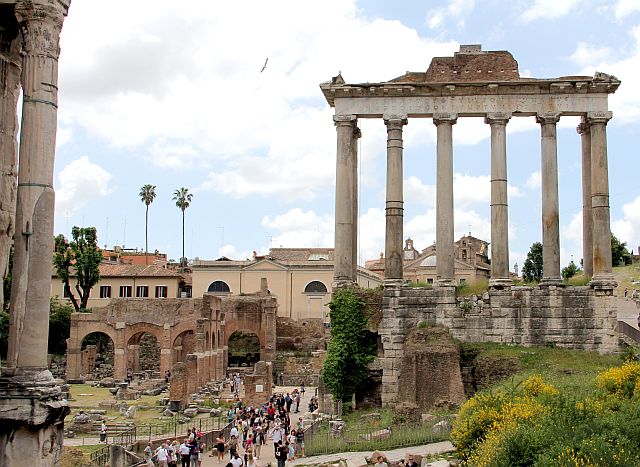
The Colosseum
Rome – The Eternal City. The joke among visitors is that it feels like an eternity of walking. The city is vast, and like many cities throughout Europe, it has an interesting blend of ancient and modern.
There are many historical sites that it would take several days to see all of it. We didn’t have that luxury.
Only five hours to spare, our day was akin to an episode of “Amazing Race,” but it was still a blessing to have the chance to visit again.
We took an early train for the over one-hour ride from the port city of Civitavecchia to St. Peter’s, the station for the Vatican City.

Anna in front of the Mamertine Prison
Anna and I had visited St. Peter’s Basilica and St. Peter’s Square, the Vatican Museum, and the Sistine Chapel previously so we did a quick visit and moved on our way.
The main reason for this trip was to see some of the ancient ruins of Rome.
Due to the traffic of a major city and the time it takes to transfer subway stations, walking is one of the quickest ways to get around. Taxi rides start around 20
Euro (about. P1,000) so walking is also the most practical way.
First stop was at the famous Trevi Fountain, a giant, lavish fountain that took 30 years to build, finally completed in 1762.
The tourist attraction is not easy to find, as it requires maneuvering through small, winding streets.
Unfortunately during our visit the fountain was under serious renovation surrounded by scaffolding.
Legend has it that if you throw a coin over your right shoulder into the fountain you are sure to return in the future. An average of 3,000 Euros are thrown into the fountain every day.
The city of Rome uses that money to fund a supermarket for the city’s poor.

The Roman Forum
Next stop was the Pantheon.
The 2,000-year-old building was originally a Greek church, then given to the Pope and converted to a Catholic church, and then since the Renaissance period has also been used as a tomb while today they still celebrate Mass on Sundays and holy days.
Some of the most notable people buried inside include the Renaissance painter Raphael, Baroque-era music composer Corelli, and members of Italian royalty. The most striking feature inside is the large oculus in the ceiling.
The 30-meter hole lets in light, and even rain.
A memorable part of our trip was the visit to the Colosseum and the nearby Roman Forum. The Colosseum is a massive open-air amphitheater that was used for its famous gladiator battles, holding up to 80,000 spectators.
The building also played host to executions, dramas, animal hunts, battle reenactments, and even mock sea battles as it could also be filled with water.
The Colosseum also has its place in the early history of the Church, as it is believed that many martyrs were executed inside.
Outside the Colosseum, a woman with her family came up to Anna and asked “Are you Anna Fegi?” We thought maybe she remembered Anna from her days on TV. When Anna said yes,
the woman told her husband, “This is the daughter of Socorro Fegi, my Christian Living teacher!
She had such an influence in my life.” The woman grew up near Lutopan, Toledo City, but now lives in Switzerland and was traveling to Rome with her parish. Anna was a very proud daughter.
A short walk from the Colosseum are the ruins of the Roman Forum. While now it looks like piles of rocks scattered about, the Forum was once the center of the ancient city of Rome. It was the site for everything from elections, public debates, marketplaces, and even gladiator battles.
The area included shrines to several of the ancient gods as well as the very first political buildings.
It was home to the very first Republican government where politicians were elected to represent the citizens. Julius Caesar had the first form of a supreme court built there on the grounds.
In the history of Christianity and Catholicism, the Forum is also the site of the Mamertine Prison, where Saint Peter and Saint Paul were held as prisoners before their executions.

St. Peter’s Square and Basilica
After our visit to the Forum, we realized that we just had time for one last stop. We decided to go to one of the most important churches in the city of Rome, which is San Paolo Fuori le Mure, or St. Paul Outside the Walls (outside the original city walls of Rome).
The original basilica was built in 324 A.D. above the grave of Saint Paul. It has been through many renovations and is one of the four papal churches in Rome. Inside is the tomb of Saint Paul and a relic of the chains believed to have been used while he was imprisoned at the Mamertine Prison.
We wanted to stay longer but had to catch the train back. So we started casually walking, and then changed to a fast walk, and then jogged through the streets of Rome. Finally made it back to the train station.
Just in time! Good thing we had already bought our return ticket as the train was already sitting at the station. As we walked up the steps to the platform the train doors closed.
I reached out and pushed the open door button but it was too late as the train was starting to move slowly down the tracks. Our hearts immediately sank.
The next train left too late in the day so we had to opt for a taxi. Unfortunately taxis are far more expensive than in Cebu and our fare was about 120 Euro (over P6,200).
But we made it back in time before our ship left the port. A very expensive lesson to pay better attention to the time, but in the end I do not regret it.
Who knows how many more chances we will get to revisit Rome in the future?

